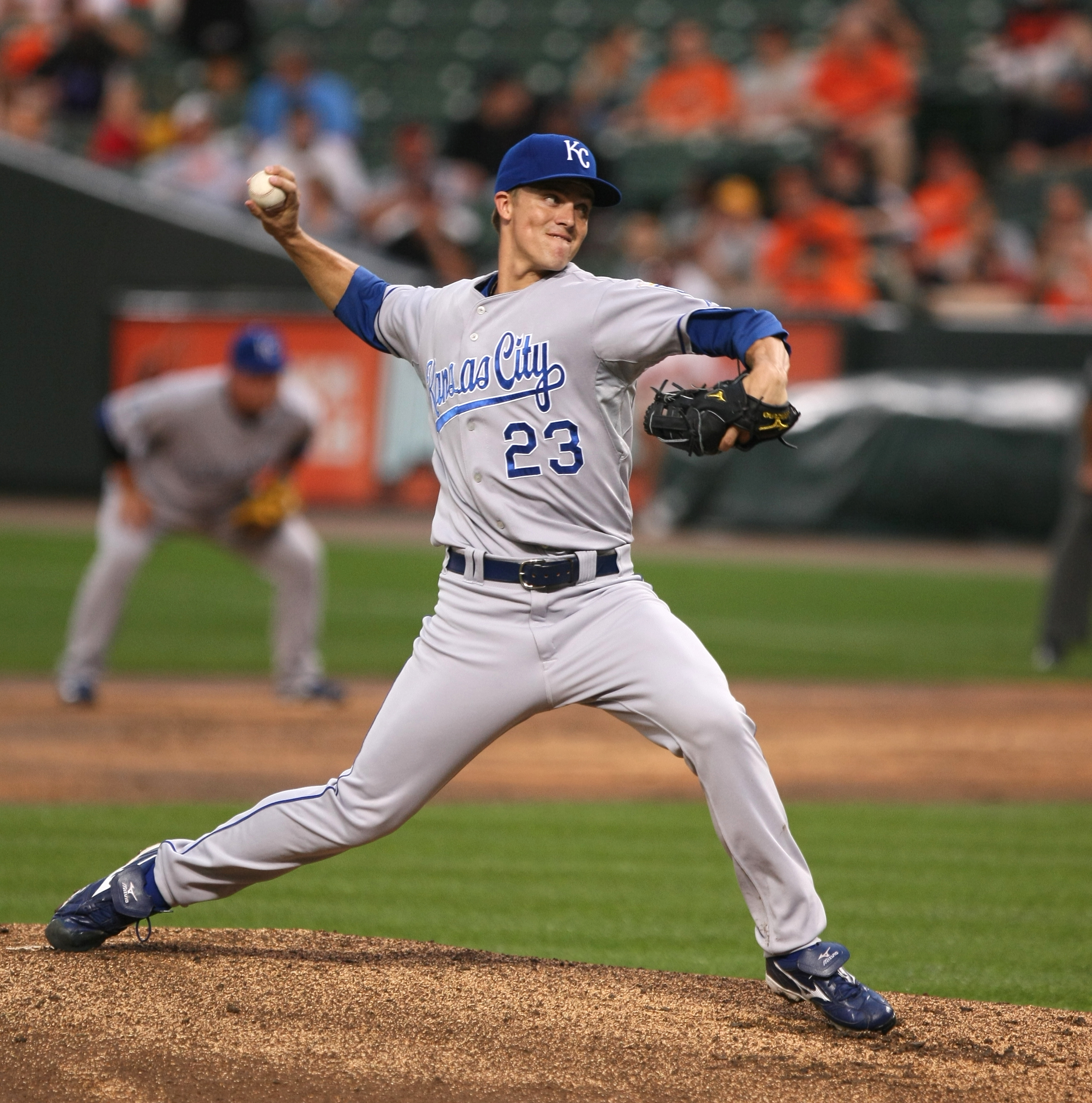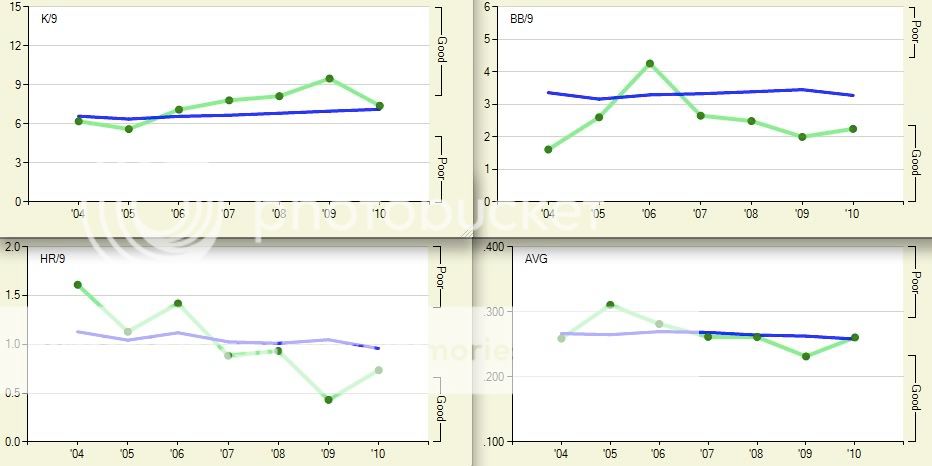Zack Greinke was the 6th overall pick of the KC Royals in 2002 and was in the majors just 2 years later. At the age of 20, he had an excellent season with an 8 – 11 3.97 season for the Royals. His 2005 wasn’t nearly as good as he finished 5 – 17 5.80 but those numbers were exacerbated by a terrible BABIP and Left On Base Percentage.
During spring training of 2006 Greinke left the team due to a diagnosis of Social Anxiety Disorder. Greinke left baseball entirely for a few months and spent most of 2006 pitching in AAA.
Greinke began 2007 in the Royals rotation and pitched well (3 – 6 3.80) in 14 starts before being moved into the bullpen.
In 2008 Greinke returned to the Royals rotation and stayed there the entire season putting up a very good line of 13 – 10 3.47.
Then 2009 came. Greinke didn’t give up an earned run in his first 4 starts and made 10 starts before giving up more than 2 runs. He pitched complete games in 4 of his first 7 starts. No one managed a home run against Greinke until June. His excellence continued the entire season as Greinke ran away with the Cy Young finishing 16 – 8 with a 2.16 ERA.
Greinke couldn’t meet the lofty expectations created by his 2009, turning in a 10 – 14 record with a 4.17 ERA.
So what happened in 2010, and what do we expect for 2011?
First, that’s sort of the wrong question. The better question is, “what happened in 2009?”
The previous graphs show that 2009 was the odd year for Greinke. Strikeouts, walks, home runs, and batting average were all better than anything that he’d previously done in his career. 2009 isn’t the baseline we should use for Greinke. 2007 and 2008 are.
How’d Greinke’s 2010 compare to his 2007 and 2008? In terms of ERA, not good.
Year: ERA, ERA+
2007: 3.47, 124
2008: 3.80, 126
2009: 2.16, 205
2010: 4.17, 100
*ERA+ compares a pitcher’s ERA to league average and adjusts for home park. 100=average. Above 100=better than average. Below 100=below average.
At first glance, it would look like Greinke had a poor (for him) 2010. But did he?
Looking back at the graphs of strikeouts, walks, home runs, and batting average, his 2010 looks very similar to his 2007 and 2008. So, why the bad ERA in 2010? The first place to look is always BABIP.
Not that. Greinke’s BABIP has been remarkably consistent since 2007. The next place to look is Left On Base Percentage
Now, there we have something. The percentage of runners that Greinke stranded in 2010 was well below his career level and well below the league average. Simply put, opposing hitters were getting more ‘clutch’ hits against Greinke than would be expected.
According to Baseball-Reference
With runners in scoring position in 2010 opposing hitters hit .297
With men on base opposing hitters hit .275
With no runners on opposing hitters hit .249
There is no real reason to expect opposing hitters to hit better with runners in scoring position as they did in 2010 (opposing hitters in general do hit better with runners on base than they do with the bases empty). Check out Greinke’s 2007 and 2008
2007 RISP .224, Men On .274
2008 RISP .234, Men On .268
In 2007 and 2008 Greinke got excellent results with runners in scoring position. In 2010, of course, he did not. Why?
2007 BABIP with runners in scoring position: .258
2008 BABIP with runners in scoring position: .295
2010 BABIP with runners in scoring position: .349
That stands out. I’ve already mentioned that Greinke’s BABIP has been very stable. So a more than 50 point jump between 2008 and 2010 seems to be nothing but bad luck in those situations. And that number is likely to be closer to .300 in 2011-leading to less runs scoring and a lower ERA.
There is one concerning thing about Greinke, however. Strikeouts. Greinke’s K/9 in 2010 was well below his established norm and right around the league average.
The following numbers are Greinke’s year-by-year percentages for pitches swung at and made contact with and swinging strike percentage.
2007 78.3, 9.8
2008 79.5, 9.3
2009 77.7, 9.9
2010 82.8, 7.5
2010 looks a lot different. Why?
Two obvious places to look are at Greinke’s pitch selection and his stuff.
Greinke’s pitch selection
2007 FB=66%, Slider=19%, Curve=8%, Change up=7%
2008 FB=62%, Slider=19%, Curve=12%, Change up=8%
2009 FB=59%, Slider=20%, Curve=14%, Change up=6%
2010 FB=61%, Slider=16%, Curve=11%, Change up=13%
Greinke is obviously using the change up more and his slider less. This is strange because his slider has consistently been his best pitch and his change up his worst. Also about half of Greinke’s fastballs in 2010 were classified as two-seam fastballs while less than 1% of his pitches the 3 previous seasons were so classified.
This chart shows Greinke’s runs saved per 100 pitches of each type for the last few years (high numbers are good. & negative numbers bad).
2007 Fastball = .57, Slider = .43, Curveball = 1.00, Change = -2.92
2008 Fastball = -.19, Slider = 2.49, Curveball = .14, Change = -1.53
2009 Fastball = 1.27, Slider = 2.90, Curveball = .50, Change = -1.21
2010 Fastball = .49, Slider = 2.34, Curveball = -1.91, Change = -.57
You can see that the slider is by far his most consistent pitch. Why would he throw it less? And why would it substitute his slider for his changeup, which is his worst pitch? I don’t have any idea. It’s worth noting that his change has been improving each year. Also note that his curveball was an above average pitch for Greinke in 2007-2009 but was terrible for him this year.
I’m far from being an expert on Pitch F/X but I’ll look at the numbers quickly.
There’s no obvious decline in Greinke’s velocity
His curveball has shown a decrease in horizontal movement. The decrease has been gradual which doesn’t explain why the decrease in effectiveness dropped off so quickly.
2007 8.1 inches
2008 7.5 inches
2009 6.1 inches
2010 4.5 inches
His slider has also shown a similar decrease in horizontal movement
2007 5.7 inches
2008 5.0 inches
2009 3.6 inches
2010 2.9 inches
So, what does it all mean?
First, Greinke v.2009 isn’t the Greinke we should be comparing to. He pitched to the best of his capabilities and everything broke right for him. We should be looking at Greinke’s 2007 and 2008 seasons as a baseline.
Greinke’s 2010 was a lot like his 2007 and 2008. The only two differences were his left on base percentage, which should return to normal and his strike out rate. Regarding his strikeout rate; he is pitching differently and his pitches are moving differently so does this strike out rate represent a new norm for Greinke? I don’t know.
For a projection I’ll say:
33 starts, 220 innings, 60ish walks, 190ish strike outs, and an ERA of 3.50 (give or take the standard half of a run). So, basically, the same Zack Greinke we’ve seen since 2007-exluding his amazing 2009 and terrible LOB% in 2010.






No comments:
Post a Comment